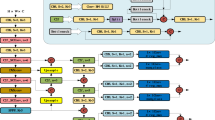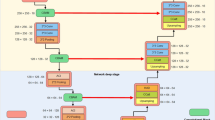Abstract
Mortar void is a hidden defect in ballastless slab track difficult to be efficiently identified by traditional detection methods. This paper is dedicated to proposing a new detection method to identify the mortar void position and length using the vehicle response combined with the hybrid convolutional neural network-support vector machine (CNN-SVM) classifier. The vertical wheelset accelerations with different mortar void conditions are collected from a vehicle-track coupled dynamics simulation model. The first components decomposed from wheel-set accelerations by local mean decomposition and their envelopes are utilized as the training data due to their sensitivity to mortar void. To improve the identification precision, the scope descent method is proposed to determine the range influenced by mortar void (IMVR) and samples are labeled according to IMVR. Meanwhile, identification results are post processed based on the mortar void characteristics. The results show that over 90 % mortar void conditions with the length of 0.65 m are detected correctly and the identification has a higher precision with the mortar void length greater than 0.95 m. The proposed technology of mortar void detection using the wheelset accelerations with the hybrid CNN-SVM classifier provides reference for engineering application, which is of great significance to relieve the pressure of health monitoring of railway track.
Similar content being viewed by others
References
S. R. Matias and P. A. Ferreira, Railway slab track systems: review and research potentials, Structure and Infrastructure Engineering, 16(12) (2020) 1635–1653.
Y. Zhang, X. Cai and L. Gao, Improvement on the mechanical properties of CA mortar and concrete composite specimens in high-speed railway by modification of interlayer bonding, Construction and Building Materials, 228 (2019) 1–13.
Y. Shan, S. Zheng and X. Zhang, Fatigue performance of the CA mortar used in CRTS I ballastless slab track under simulated servicing condition, Materials (Basel), 11(11) (2018) 1–15.
S. Zhu, Q. Fu and C. Cai, Damage evolution and dynamic response of cement asphalt mortar layer of slab track under vehicle dynamic load, Science China Technological Sciences, 57(10) (2014) 1883–1894.
S. Y. Zhu and C. B. Cai, Interface damage and its effect on vibrations of slab track under temperature and vehicle dynamic loads, International Journal of Non-Linear Mechanics, 58 (2014) 222–232.
Y. Li, J. Chen and J. Wang, Study on the interface damage of CRTS II slab track under temperature load, Structures, 26 (2020) 224–236.
J. Ren, J. Wang and X. Li, Influence of cement asphalt mortar debonding on the damage distribution and mechanical responses of CRTS I prefabricated slab, Construction and Building Materials, 230 (2020) 116995.
P. Wang, H. Xu and R. Chen, Effect of cement asphalt mortar debonding on dynamic properties of CRTS II slab ballastless track, Advances in Materials Science and Engineering, 2014 (2014) 193128.
C. Yu, J. Xiang and J. Mao, Influence of slab arch imperfection of double-block ballastless track system on vibration response of high-speed train, Journal of the Brazilian Society of Mechanical Sciences and Engineering, 40(2) (2018) 109.
Z. W. Li, W. F. Zhu and X. Z. Meng, Multi-layer imaging method for void defects in ballastless track using forward ray tracing with SAFT, Measurement, 173 (2021) 108532.
W. F. Zhu, X. J. Chen and Z. W. Li, A SAFT method for the detection of void defect inside a ballastless track structure using ultrasonic array sensors, Sensors (Basel), 19(21) (2019) 4675–4689.
X. Tian, W. Zhao and Y. Du, Detection of mortar defects in ballastless tracks of high-speed railway using transient elastic wave method, Journal of Civil Structural Health Monitoring, 8(1) (2017) 151–160.
A. Che, Z. Tang and S. Feng, An elastic-wave-based full-wavefield imaging method for investigating defects in a highspeed railway under-track structure, Soil Dynamics and Earthquake Engineering, 77 (2015) 299–308.
J. Xu, P. Wang and H. Liu, Identification of internal damage in ballastless tracks based on Gaussian curvature mode shapes, Journal of Vibroengineering, 18(8) (2016) 5217–5229.
G. Guo, J. Wang and B. Du, Application study on fiber optic monitoring and identification of CRTS-II slab ballastless track debonding on viaduc, Applied Sciences, 11(13) (2021) 6239–6263.
Q. Hu, Y. J. Shen and H. P. Zhu, A feasibility study on void detection of cement-emulsified asphalt mortar for slab track system utilizing measured vibration data, Engineering Structures, 245 (2021) 112349.
M. Su, H. Xie and C. Kang, Determination of the interfacial properties of longitudinal continuous slab track via a field test and ANN-based approaches, Engineering Structures, 246 (2021) 113039.
J. Ren, W. Du and W. Ye, Contact loss identification of CA mortar in prefabricated slab track based on PSO-SVM, Journal of Central South University (Science and Technology), 52(41) (2021) 4021–4031 (in Chinese).
Y. B. Yang, Z. L. Wang and B. Q. Wang, Track modulus detection by vehicle scanning method, Acta Mechanica, 231(7) (2020) 2955–2978.
M. Molodova, Z. Li and R. Dollevoet, Axle box acceleration: Measurement and simulation for detection of short track defects, Wear, 271(1–2) (2011) 349–356.
E. Bernal, M. Spiryagin and C. Cole, Onboard condition monitoring sensors, systems and techniques for freight railway vehicles: a review, IEEE Sensors Journal, 19(1) (2019) 4–24.
H. Shi, Z. Yu and H. Shi, Recognition algorithm for the disengagement of cement asphalt mortar based on dynamic responses of vehicles, Proceedings of the Institution of Mechanical Engineers, Part F: Journal of Rail and Rapid Transit, 233(3) (2018) 270–282.
J. Ren et al., Criteria for repairing damages of CA mortar for prefabricated framework-type slab track, Construction and Building Materials, 110 (2016) 300–311.
A. Ganatra, Support vector machine classification methods: A review and comparison with different classifiers, Data Mining Knowledge Engineering, 3(1) (2011) 45–52.
X. X. Niu and C. Y. Suen, A novel hybrid CNN-SVM classifier for recognizing handwritten digits, Pattern Recognition, 45(4) (2012) 1318–1325.
H. Wu, Q. Huang and D. Wang, A CNN-SVM combined model for pattern recognition of knee motion using mechanomyography signals, Journal of Electromyography and Kinesiology, 42 (2018) 136–142.
Z. Huang, M. Sun and C. Guo, Automatic diagnosis of Alzheimer’s disease and mild cognitive impairment based on CNN + SVM networks with end-to-end training, Computational Intelligence and Neuroscience, 2021 (2021) 9121770.
S. Kundu and S. Ari, P300 based character recognition using convolutional neural network and support vector machine, Biomedical Signal Processing and Control, 55 (2020) 101645.
W. Da Silva Cotrim, L. Felix and V. Minim, Development of a hybrid system based on convolutional neural networks and support vector machines for recognition and tracking color changes in food during thermal processing, Chemical Engineering Science, 240 (2021) 116679.
W. Feng, N. V. Halm-Lutterodt and H. Tang, Automated MRI-based deep learning model for detection of Alzheimer’s disease process, International Journal of Neural Systems, 30(6) (2020) 2050032.
Z. Li, W. Gui and J. Zhu, Fault detection in flotation processes based on deep learning and support vector machine, Journal of Central South University, 26(9) (2019) 2504–2515.
L. Hoang, S. H. Lee and K. R. Kwon, A 3D shape recognition method using hybrid deep learning network CNN-SVM, Electronics, 9(4) (2020) 649–662.
X. Lei and J. Wang, Dynamic analysis of the train and slab track coupling system with finite elements in a moving frame of reference, Journal of Vibration and Control, 20(9) (2013) 1301–1317.
S. Zhang, The Beijing-Tianjin Inter-City High-Speed Railway System Debugging Techniques, China Railway Publishing House, Beijing, China (2008) (in Chinese).
P. Xu and C. Cai, Dynamic analysis of longitudinally connected ballastless track on earth subgrade, Journal of Southwest Jiaotong University, 46(2) (2011) 189–194 (in Chinese).
H. Nan, Analysis on the Dynamic Characteristics of CRTS II Type Slab Ballastless Track on Subgrade and the Parametric study, Lanzhou Jiaotong University, Lanzhou, China (2012) (in Chinese).
Y. Wang, Z. He and Y. Zi, A comparative study on the local mean decomposition and empirical mode decomposition and their applications to rotating machinery health diagnosis, Journal of Vibration and Acoustics, 132(2) (2010) 613–624.
P. Chen, H. Chen and W. Chen, Improved ensemble local mean decomposition based on cubic trigonometric cardinal spline interpolation and its application for rotating machinery fault diagnosis, Advances in Mechanical Engineering, 12(7) (2020) 1–19.
J. S. Smith, The local mean decomposition and its application to EEG perception data, Journal of the Royal Society Interface, 2(5) (2005) 443–454.
Y. Li, Q. Wang and T. Wang, Feature extraction of EEG signals based on local mean decomposition and fuzzy entropy, International Journal of Pattern Recognition and Artificial Intelligence, 34(12) (2020) 2058017.
M. Peng, Z. Wu and Z. Zhang, From macro to micro expression recognition: deep learning on small datasets using transfer learning, 13th IEEE International Conference on Automatic Face and Gesture Recognition, FG 2018, Xi’an, China (2018) 657–661.
J. Li, Y. Liu and Q. Li, Generative adversarial network and transfer-learning-based fault detection for rotating machinery with imbalanced data condition, Measurement Science and Technology, 33(4) (2022) 045103.
X. Pan, T. Phan and M. Adel, Multi-view separable pyramid network for AD prediction at MCI stage by (18)F-FDG brain PET imaging, IEEE Trans Med Imaging, 40(1) (2021) 81–92.
Acknowledgments
This work is supported by National Natural Science Foundation of China (Grant Nos.11790281, 62103037), China.
Author information
Authors and Affiliations
Corresponding author
Additional information
Xin Xin is a Ph.D. candidate at the School of Mechanical, Electronic and Control Engineering, Beijing Jiaotong University, Beijing, China. Her research interests include vehicle-track coupling dynamics and structural damage identification.
Zunsong Ren is a Professor the School of Mechanical, Electronic and Control Engineering, Beijing Jiaotong University, Beijing, China. He received his Ph.D. in Mechanical Engineering from Southwest Jiaotong University. His research interests include vehicle-track coupling dynamics, strength and reliability of the vehicle structures, and load spectrum.
Yi Yin is an Associate Professor of the School of Mechanical, Electronic and Control Engineering, Beijing Jiaotong University, Beijing, China. She received her Ph.D. in Statistics from Beijing Jiaotong University. Her research interests include statistics, strength and reliability of the vehicle structures, and load spectrum.
Jinsheng Gao is a Ph.D. student at the School of Mechanical, Electronic and Control Engineering, Beijing Jiaotong University, Beijing, China. He received the M.S. degree in Industrial Engineering from Beijing Jiaotong University. His current research interests include operations research, intelligent heuristic and artificial intelligence.
Rights and permissions
About this article
Cite this article
Xin, X., Ren, Z., Yin, Y. et al. Intelligent identification of mortar void in ballastless slab track using the wheelset acceleration combined with CNN-SVM. J Mech Sci Technol 36, 5845–5857 (2022). https://doi.org/10.1007/s12206-022-1103-9
Received:
Revised:
Accepted:
Published:
Issue Date:
DOI: https://doi.org/10.1007/s12206-022-1103-9




